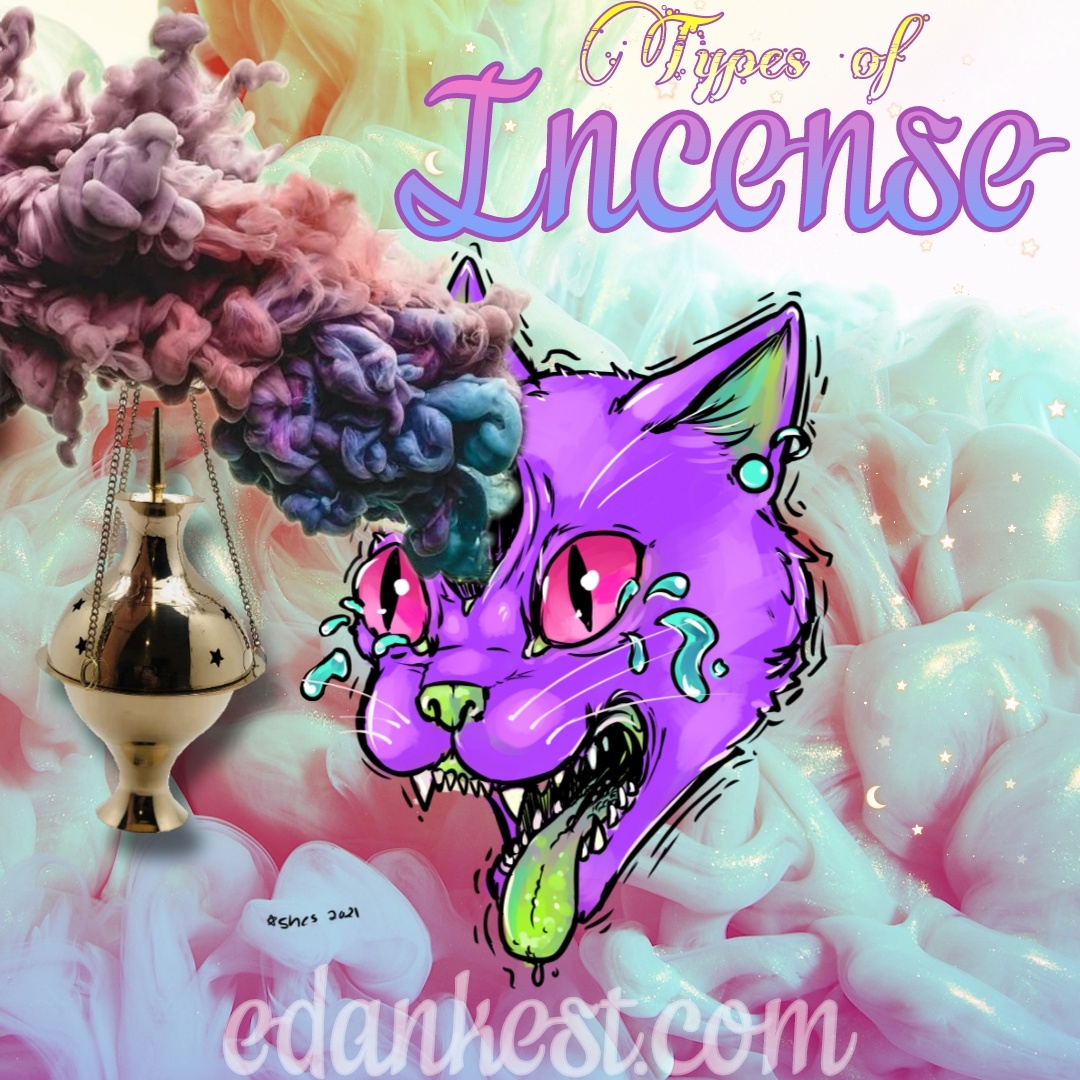Types of Incense

Most of us think of cones or sticks when we think about burning incense. Oh, but there are so many, many kinds of incense far beyond just sticks and cones! Let's take a look at the wide variety of incense and how to burn them.
There is something to be said about humans and our connection to aromas and fragrance with the use of incense and oils dating back to ancient times. A wealth of information regarding their historical, cultural, religious, spiritual, and contemporary uses would be impossible to cover in a single blog post. An attempt to cover it all here would be a disservice to the role incense have had in relation to humans across the globe throughout time. Instead, let's focus on some of the different kinds of incense, what they are, and how to best utilize them.
Indirect-burning Incense vs Direct-burning Incense
Incense can easily be split into two different general categories: direct-burning and indirect-burning incense. Both categories are a great description for how incense that fall under each type function as the categories are both self-explanatory. Direct-burning incense are lit by using a flame directly on the incense, i.e. using a lighter on the tip of an incense stick to create a small flame before blowing it out. Indirect-burning incense are lit by using a separate heat source instead of a flame, i.e. fully igniting a charcoal disc and placing pieces of resin incense on top of the charcoal.
Indirect-burning incense
What you need to get started: A censer, incense sand or an alternative to control the heat, charcoal, a lighter or an alternative to light the charcoal, and your choice of indirect-burning incense.
Resin incense might sound unfamiliar, but frankincense and myrrh likely ring a bell to those of us that have grown up in western society especially if you're from Midwest. Christianity has highlighted this particular pairing of resin incense, but it's just one of many resin incense available. Another kind of resin incense you've likely heard of, albeit not necessarily in resin form, is Dragon's Blood! This beloved scent that many people have come to know and love, Dragon's Blood, comes from resin obtained from the Calamus family of plants, colloquially referred to as Palm trees.
Whole incense like Palo Santo wood sticks or wood chips, leaves of sage or eucalyptus, and herbs like lavender and rose buds are all examples of a kind of incense you can place directly on top of a coal and allow to burn for their potent aromatic fragrances. These whole forms of incense, like resin incense, take longer to burn than other types of incense with the smaller forms burning quicker.
Powdered / Granulated Incense are a form of indirect-burning incense that have been broken down further for faster burning. You can find ground herbs or grind them yourself using a mortar and pestle. Palo Santo can be purchased in powdered form. Even resin incense can be broken down into small, granulated pieces. The smaller pieces and powders provide a quick burst of aroma that burns quickly. It's easy to customize a fragrance to your liking by choosing a variety of material and grinding them down together into your very own mixture.
Direct-burning Incense
What you need to get started: a lighter or an alternative flame source, your choice of direct-burning incense, and an incense burner appropriate for the specific type of incense you will be burning, which will vary depending on what kind of incense you're using.
Stick Incense
This is one of the most common types of incense used in the United States. Once you have an incense burner that will accommodate your incense stick, you may place it in the burner to light it or hold it in your non-dominant hand at a slight upward angle. With your dominant hand, use an open flame source like a lighter or candle wick to light the tip of the incense. Let the tip burn for a few moments before blowing it out or fanning the flame out. You should be left with a glowing ember at the end of the stick that will burn down the rest of the stick.
- Cored Incense Sticks
This subtype of incense stick has a core of bamboo, sometimes sandalwood depending on the quality. The core is coated with the fragrant incense material. Both the incense material and the core inside burn away together leaving a thin trail of ash behind caught by the incense holder.
- Solid Incense Sticks
Sometimes referred to as dhoop incense, these sticks are made of solid incense material. The lack of a core in solid incense makes it easy to break them apart, which allows them to be quickly broken into different sizes. The ability to customize the size, which will influence the time it takes to burn, is perfect to cater to an individual's needs at any given time.
Cone Incense
Just like solid incense sticks, cone incense are made using a paste made with powdered incense material, binding agents, and water. The paste is then shaped using a cone mold before removing the cone and allowing it to dry. Cones tend to burn faster than cored incense sticks do. Lighting cone incense works the same way as stick incense. Once lit and allowed to burn for a moment, a glowing ember should remain at the tip after the flame has been fanned or blown out. Cone incense can be used on any incense burner that will not burn alongside the cone. Typically cone incense burners will have a metal or ceramic divot to place the cone in.
- Backflow Incense
Backflow cones are a subtype of cone incense that emit thick smoke from the bottom of the cone. This is accomplished by hollowing a tunnel into the middle of the incense from the bottom without piercing through the top of the cone or stick. Backflow incense can be made in solid stick form as well, but it is far less common. Special incense burners have been designed for backflow incense cones to take advantage of the unique effect of smoke flowing downward. A common type of backflow burner is designed like a waterfall.
Rope Incense
Making rope incense is a process. First incense powder is taken and rolled into paper sheets, then into ropes. These ropes are tightly twisted before doubling over and twisting them tightly again to create a two-strand rope. There is a fatter end and a thinner end. The wide end, also called the bight, can be stood upright in a dish of sand or in an incense burner designed for rope incense while the other end is lit. Another type of incense burner used for rope incense is designed using wire to hang the rope incense above a base. The base is typically made of clay, but not always. The base functions as a way to catch ash as the rope incense burns in addition to keeping the wire that holds the rope stable.
Coil Incense
Not so different from solid stick incense, coil incense are made in a spiral shape instead of a straight shape. The unique design of coil incense allows them to be made with extra length, thus they burn longer than stick incense. Depending on the size of the coil incense they can take hours or even days to burn them entirely. There are a wide variety of coil incense burners available to purchase in many shapes and styles. The most common coil incense found in the US, especially the Midwest, is citronella coil incense to keep mosquitos away while spending time outdoors. Although citronella is available in other forms like candles, citronella coil incense is an outdoor staple in the summer months in the Midwest.
Paper Incense
Aromatic oils and resins are extracted from a variety of fragrant sources. The fragrant extractions are infused into paper. One of the oldest kinds of paper incense is called Armenian Paper which has been produced for centuries. A popular example of Armenian Paper incense is Papier d'Arménie. Papier d'Arménie, produced in France, translates directly to Paper of Armenia. To burn Papier d'Arménie, a strip of paper incense is torn from a sheet inside the booklet. The paper is then folded repeatedly to resemble an accordion, placed on a heat-resistant dish or paper incense burner, lit with an open flame, blown out, and blown on until the paper emits the glow of ember and releases the aromas of the paper incense. More contemporary versions of paper incense have come out of Japan. These paper incense are made from Japanese washi paper and often presented in ornamental shapes like leaves. With these paper incense they can be burned as is or left unburned as a kind of potpourri.
There are so many different kinds of incense out there. With peoples' love of aromas and knack for innovation, new types and subtypes are likely to arise. New practices will crop up over time. The incense compiled in this post is certainly not an exhaustive list and there are types of incense that aren't mentioned here at all, like incense matches. One of the beautiful things about incense is the wide variety to choose from, allowing people to find their favorite scents, types, and ways to use them. What works best for you might not work best for your neighbor. We all have different living situations that call for different practices.
When you find that perfect scent in your preferred form, it truly feels divine.
I implore you to experiment and find what works best for you. Check out our selection!
Explore. Have fun. Be well!

Comments
Be the first to comment...